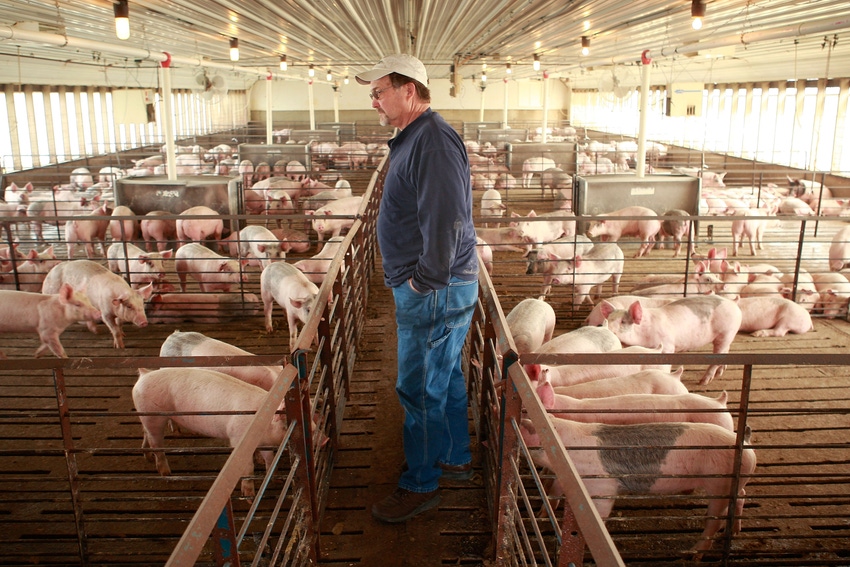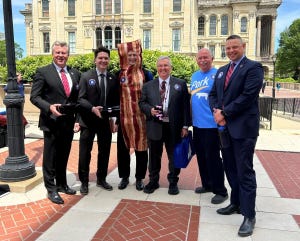Pork Month brings optimism, challenges
The national recognition of pork in October is a good reminder to all pork producers to share his or her story with consumers locally and worldwide.


IPPA President Al Wulfekuhle of Quasqueton addresses the media during the governor’s news conference. Photo: Iowa Pork Producers Association.
October is marked as National Pork Month because it is traditionally the time of year that large quantities of hogs are brought to market by America’s pig farmer. And this year is no exception with growth in pork production as result of low disease pressure, enhanced production efficiencies and modest expansion.
Al Wulfekuhle, Iowa Pork Producers Association president, and pork producer says, “It is a law of business that expansion follows profitability, and we have had a couple of profitable years. Our industry keeps getting better with more pigs per sow per year, and we keep getting more efficient. We are just too good at what we do.”
Pork production is serious business in Iowa. The prime location with local access to corn, soybeans and processing plants combined with a supportive business climate assists the state’s pig farmers to raise one-third of U.S. pork and take bragging rights as the leading pork-producing state.
Although a record pork production year lowers the price of pork at the meat counter, it creates profitability challenges for hog farmers. Wulfekuhle frankly says it is a scary time for pork producers. According to the recently released USDA Hogs and Pigs Report, there is going to be 2% more hogs going through the processing plants this winter, stretching packer capacity further.
“We are walking on pins and needles, hoping we do not have any plant breakdowns or delays and hogs get processed without backing up. If we back the pigs up then they just get heavier and prolongs the problem,” says Wulfekuhle.
While relief is on the way with five new pork packing plants coming nationwide, they will not be operational until 2017 and 2018. The largest plants are on track to open their doors in the Iowa area.
So, for the next four to six months it is going to be rough for all U.S. hog farmers. However, more pork coming to the marketplace does not mean pig farmers sacrifice the quality of the product. It just translates to affordable animal protein options for the consumer.
Pork, a global favorite
Pork is the world’s most widely eaten meat, representing 36% of all meat consumed, according to the USDA Foreign Agricultural Service. Overall, demand for pork domestically and abroad is good.
“Consumers recognize the versatility of serving pork in their homes,” says Wulfekuhle. “That is what is so great about pork. It absorbs flavor well. It is a lean, nutritious and low-cost product.”
For the most part, the consumption of pork domestically is vigorous and stable. However, the true market growth potential is the export market. Twenty-five percent of the U.S. pork is exported. The United States became a net exporter of pork in the 1990s, so any new growth occurs in the international marketplace. Wulfekuhle says, “In reality, most increased supplies have gone to exports.”
In 2015, Iowa exported $1.1 billion worth of pork products with Japan, Canada, Mexico and South Korea being the leading customers.
Wulfekuhle will join Iowa’s Gov. Terry Branstad and the state’s beef leaders in a trade mission to Japan and China in November. During his two tenures as governor, this trip will mark Branstad’s 17th trip to Japan and sixth to China.
“Trade missions like this one allow Iowa companies to expand their markets outside of the U.S. and ultimately creates more jobs and strengthens our economy,” says Branstad, during a press conference announcing the upcoming trade mission.
This trade mission comes at a crucial time as U.S. pork faces rigid competition from other countries. Although these trade missions pull Wulfekuhle away from the farm, it is time well spent explaining pork production to international meat buyers. He says, “It is building a relationship with these countries. You can do that with meeting them one-on-one and letting them know you care.”
It also gives them a direct avenue to ask questions about pork production. Wulfekuhle says the dialogue continues long after he returns to the state.
Still, the national recognition of pork in October is a good reminder to all pork producers to share his or her story with consumers locally and worldwide. He says, “We get a lot of questions from consumers, especially in the United States, about how the product is raised and if we care about the environment. I think the message we keep getting is we need to show that we do care.”
About the Author(s)
You May Also Like


